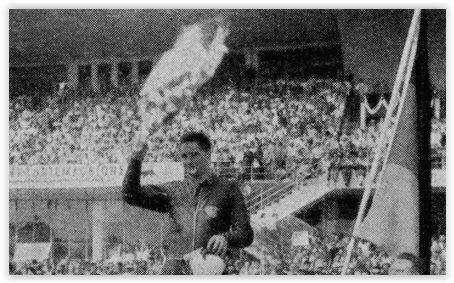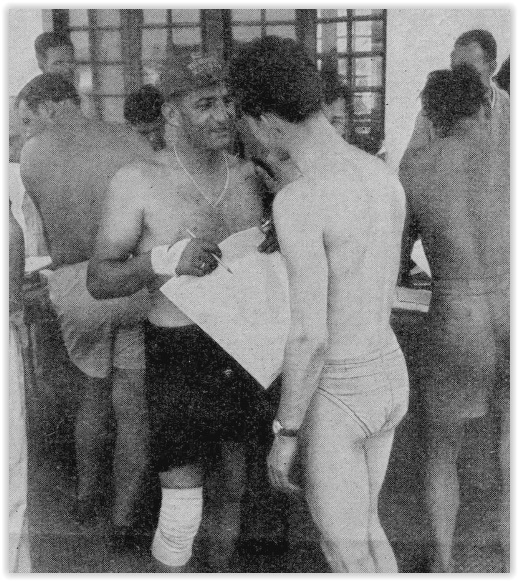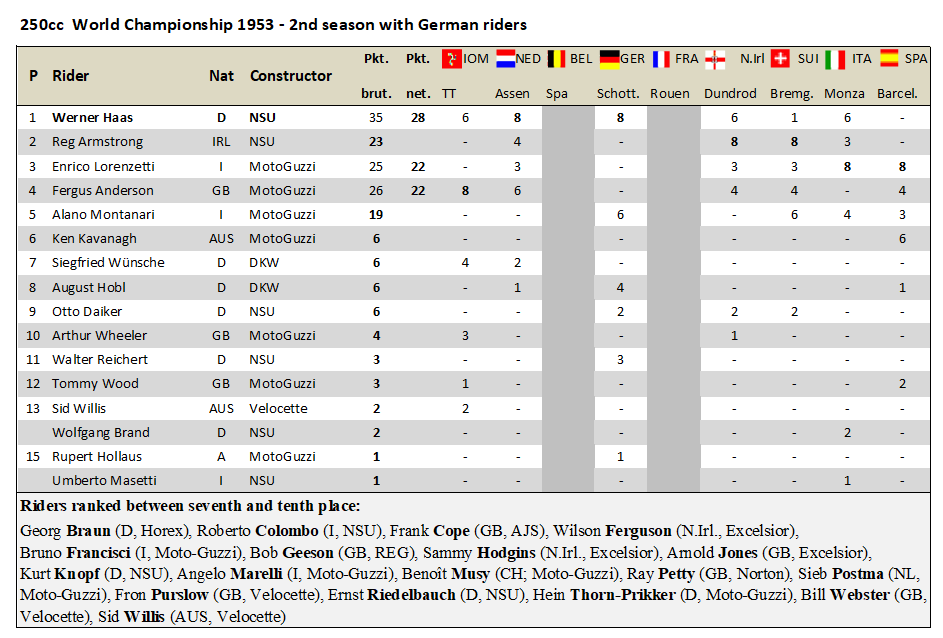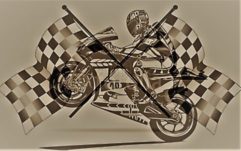
Early final of the 1953 Motorcycle World Championship
After the title decision in the 350cc class for solo machines had only been made before Monza and Fergus Anderson (Moto-Guzzi) had already been confirmed as the new champion, the second to last lap at the Grand Prix of Nations took on particular significance. As our following summary of the second to last of nine rounds of the 1953 Motorcycle World Championship shows, those attending this event had definitely spent their money well and should not be disappointed at all this weekend. In the 125s, the starting position was crystal clear; if NSU ace Haas won, the title could no longer be taken away from him before the final in Montjuic Park in Barcelona. The MV pilots Sandford and Ubbiali behind them had to risk everything to beat the German shooting star in order to secure the last chance for the 125cc world championship. NSU figurehead Haas was also able to take the title early in the 250s if he finished ahead of Armstrong and in this case even two victories in a row would no longer be of any use to the Italian Lorenzetti, who was left behind in the intermediate rankings. Similar to Geoff Duke in the premier class. If the Englishman wins and neither Milani, Kavanagh or Armstrong collect enough points in Monza, Duke would no longer be able to take away his fourth title in a motorcycle world championship.

GP of the Nations with the dramatic race of the 125cc class
The title would have been secured for Werner Haas even if last year’s runner-up and title holder from 1952, Carlo Ubbiali, had not won. Because the German had a terribly bad start, his fans pinned all their hopes on Emilio Mendogni on his Moto-Morini to beat the MV rider. The leading group with Ubbiali, Mendogni and his MV Agusta factory team colleague Copeta were almost unassailable at the front early on. But completely unexpectedly, Haas’ NSU obviously began to feel more and more comfortable in the last third of the race, despite or perhaps because of the great heat. After his machine seemed to be stuck in the first part of the race, it suddenly ran as if its pilot had switched on a turbo. With between four and 6 seconds per lap, the Swabian gained more and more ground until he appeared in the slipstream of Ubbiali and Mendogni. The World Championship leader went into the final lap almost 50 meters behind the two Italians. Amid thunderous shouts from the spectators, the local heroes tried to leave the German behind in the final kilometers. But Werner Haas swerved out of the slipstream shortly before the finish and flew past Ubbiali and then Mendogni to take victory and thus the first world championship title of his career and for NSU. After the race it became known that the carburettor setting on his NSU was not suitable for the initially humid climate and that his engine ran better and better as the heat increased.


The starting position before the second to last 250cc GP of the season
The German fans and reporters were a little worried that Werner Haas would arrive in Italy somewhat drained after a strenuous season. Their fears were further fueled by the initial problems in the 125cc race and therefore confidence was correspondingly low before the penultimate Grand Prix of the season up to 250 cc, which affected the NSU figurehead. After all, he had competed in numerous internationally advertised races in the same year and in 1953 he also became two-time German champion up to 125 and 250 cc. In addition to the Swabian, his new teammate Armstrong and Anderson (Moto-Guzzi) also had a chance of winning the World Championship. The latter’s factory team colleagues were supported by Lorenzetti, Kavanagh and also Montanari in the factory’s home race, who were supposed to go for victory if he failed in order to prevent the NSU pilots from getting a good placing. In addition, the Guzzis ran excellently in training and at top speed they seemed clearly superior to the Rennmax from Neckarsulm. But NSU also strengthened itself with half-liter champion Masetti, who was supposed to support their two World Cup aspirants alongside the German brand.


The early title decision in the quarter liter class
Before the start, Anderson was still hectic because the fuel pump on his Guzzi had to be changed and he couldn’t warm up his machine properly afterwards. Behind “Sissi” Wünsche (DKW) and Lorenzetti (Guzzi), Haas only came away from the start in third place. But Anderson couldn’t move at all because his engine didn’t start at all during the push start. Despite diligently changing the spark plugs, the race and therefore the World Championship was over for the Englishman and he gave up in frustration. Kavanagh, who was loaned to Moto-Guzzi by Norton for this race, also had huge problems at the start and needed a mechanic, which is why he was subsequently disqualified. After the first lap things looked even better for Haas because Reg Armstrong had crashed after a collision with another pilot and in a hopeless position he no longer had a chance of a top spot. At the front, Lorenzetti on the Guzzi and NSU ace Haas had a duel worth seeing, with the German now taking second place to win the title. That’s why he didn’t risk too much and let the local hero go towards the end, who was enthusiastically celebrated by his compatriots after his victory. But Haas and NSU are even happier after their early title decision in the quarter-liter class and the resulting double world championship. While Masetti took 6th place despite the pit stop, Montanari ended up catching Armstrong and Brand to complete the podium. Unfortunately, Wunsch, who had been in P3 for a long time in the best DKW, was eliminated.


The category up to 350cc with the last race of the season
The only class that was not advertised in Barcelona also saw a decision about victory that was definitely worth seeing until shortly before the end. However, after AJS, MV and Norton were abandoned by the factory, DKW and the private drivers in particular benefited with a significantly higher chance of winning championship points. But the Guzzi drivers with Lorenzetti, Anderson and Agostini claimed victory among themselves. The three teammates were able to break away from the rest of the field early on and ultimately cross the checkered flag in the aforementioned order. Despite a good performance, all of the DKW pilots except Hobl failed to finish, which meant that, apart from the German, his compatriots Hofmann and Wunsch and the two Englishmen Wood and Parry were eliminated. Even veteran H.P. Müller on his Schnell-Horex narrowly missed out on the points due to bearing damage on his single-cylinder engine. Otherwise the fast man from Bielefeld could have fought with Hobl for P4. Unfortunately, there was no counter for 7th place at that time.

The premier class with once again the superior superstar Duke
With Gilera, the Englishman, who left Norton after the 1952 season, had definitely backed the right horse. On the extremely fast track in the royal park of Monza, the four-cylinder competitors from MV Agusta and Moto-Guzzi had no chance. Local hero Bandirola was initially able to keep up with Duke and Dale on his MV until a fortunately harmless crash threw him out of the race. The reigning 125cc world champion Sandford on another MV was initially in P3 until he was overtaken by compatriot Liberati, the Frenchman Pierre Monneret and the Irishman Armstrong (all on Gilera). However, Monneret then fell back again and Fergus Anderson on his Guzzi equipped with monstrous casing had to give up, while old master “HaPe” Müller had better luck this time than with the 350s and, despite initial clutch problems, achieved an excellent sixth place on his private MV. Incidentally, the factory teams from AJS and Norton also decided not to start in the half-liter class. However, with their one and two-cylinder engines they would have been hopeless against the Italian manufacturers anyway.



The final round in Catalonia
The course on public roads in Barcelona’s Montjuic city park was dangerous enough in itself. This time, however, it rained and that made things a lottery for some pilots. One of the first to get caught in the extremely difficult conditions was the newly crowned world champion Werner Haas in the 125s. After a failed attack on MV Agusta Copeta, the German skidded and flew into the straw bales, sustaining a painful bruise on his shoulder. He even continued driving afterwards and fought his way back to P8 before a broken footrest finally forced him to retire. Copeta then won ahead of MV brand colleague Sandford and the Austrian Hollaus on the best NSU, who we should hear more about soon. Teammate Wolfgang Brand came fourth ahead of the Spaniard Cama on Montesa and private driver Braun (Germany, FB-Mondial). Ubbiali had set the fastest lap, but didn’t see the checkered flag due to ignition problems, nor did NSU works driver Daiker, who was in P3 for a long time, due to a dead engine. MV took the brand title, tied on points with NSU, thanks to a better time after adding up the best finishes. However, the fact that they would lose the drivers’ title to the German brand was unexpected for the Italians and therefore very annoying. Cecil Sandford also pushed Carlo Ubbiali from second place thanks to second place in the final race and thus took the runner-up title.

Meaningless 250cc Spanish Grand Prix
After winning the title and the brand championship, NSU decided not to take part in the 250cc race, also because flagship Haas was suffering from a shoulder injury. This meant that the Guzzis had an easy time with Lorenzetti ahead of Kavanag, Anderson, Montanari and Wood. Hobl saved the honor for DKW with 6th place and thus the last World Championship point. Behind him was Hollaus on the private Guzzi, who had previously fought with Kavanag and had fallen behind due to a fall. Behind the Austrian, German pilots Hein Thorn-Prikker (Guzzi), Georg Braun (Horex) and Kurt Knopf arrived at the finish on a private NSU. In contrast to Marcelo Cama in the 125cc, no Spaniard was able to classify up to 250cc. As in the category up to 125cc, in the 250cc there were a total of 6 pilots from Germany, which had only been eligible to compete since 1952, who scored world championship points and one of them, Haas, even won the title, with NSU even on a German motorcycle. It could definitely be said that this was the biggest sensation of 1953.

Last round of the premier class in Catalonia
Superstar Geoff Duke was able to save himself from having to compete in Barcelona, as the Englishman was already confirmed as the 500cc world champion before the final round. That’s why no decision could be made here at the last race of the season, also because Gilera had long since won the manufacturer’s championship. After the start of the premier class, Pierre Monneret was the first victim. The Frenchman was stopped by a defective capacitor. The field of riders was led by Anderson after the first lap, followed by Armstrong and Kavanagh. Behind them Dickie Dale, Lorenzetti on the 350cc Guzzi, Wood and Goffin. A little later, Lorenzetti grabbed Dale in front of him and Anderson was overtaken by Kavanagh. The latter two then attacked Armstrong. The Irishman fought back as best he could, but he overdid it a little in the tenth lap and crashed his Gilera. He remained uninjured, but the race was over for him. In the end it was Anderson who crossed the checkered flag on his Guzzi ahead of Bandirola (MV), Dale, Colnago, Pagani (all three Gilera) and Wood with the last point on the Norton. Fergus had gained a lead of almost half a minute over his nearest pursuer. Despite his crash, Armstrong became runner-up behind Duke and Kavanagh missed third place behind Milani because he didn’t score a point in Spain.



Grand Prix race results 1953





Unless otherwise stated, this applies to all images (© MotoGP).

No Comments Yet